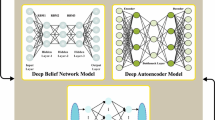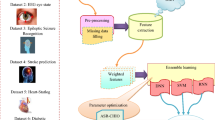Abstract
Heart diseases (HD) in humans are the most common cause of death. In the current global environment, the early detection of HD is a challenging process. The goal of this work is to develop a deep learning technique and to test the necessary classification model to improve HD detection. Hybrid optimization deep learning-based ensemble classification for heart disease is devised in this research for HD detection. Here, the input data are acquired from the dataset and preprocessed. Then, preprocessed data are subjected to the feature fusion scheme that is carried out by congruence coefficient and overlap coefficient enabled deep belief network. Consequently, with the feature fusion output, heart disease prediction classification is done by the proposed social water cycle driving training optimization (SWCDTO) ensemble classifier, which is devised using the driver training-based optimization algorithm and social water cycle algorithm. This method can efficiently train multiple classifiers to improve their efficiency. These results are combined to produce the final results. Moreover, the introduced SWCDTO-based ensemble classifier approach compared with different heart disease prediction algorithms shows better performance regarding the evaluation measures such as specificity, accuracy, and sensitivity with better values of 95.84%, 94.80%, and 95.36%. Overall the proposed method has low computational time and thus improves efficiency.



Similar content being viewed by others
Availability of data and materials
The data underlying this article are available in Heart Disease Dataset taken from https://archive.ics.uci.edu/ml/datasets/heart+Disease. In the case of real data, the data (Real database) underlying this article cannot be shared publicly due to privacy. In case of no data, no new data were generated or analyzed in support of this research.
References
Nashif, S., Raihan, R., Islam, R., Imam, M. H.: Heart disease detection by using machine learning algorithms and a real-time cardiovascular health monitoring system, 6(4), (2018)
J. P. Li, A. U. Haq, S. U. Din, J. Khan, A. Khan, and A. Saboor, "Heart Disease Identification Method Using Machine Learning Classification in E-Healthcare," in IEEE Access, vol. 8, pp. 107562–107582, 2020.
Nagavelli, U., Samanta, D., & Chakraborty, P.: Machine learning technology-based heart disease detection models. J. Healthc. Eng, 2022 (2022)
Subramani, S., Varshney, N., Anand, M. V., Soudagar, M. E., Ahmed, L., Upadhyay, T. K., Alshammari, N., Saeed, M., Subramanian, K., Anbarasu, K., & Rohini, K.: Cardiovascular disease prediction by machine learning incorporation with deep learning. Front. Med., 10 (2023)
Bharti, R., Khamparia, A., Shabaz, M., Dhiman, G., Pande, S. and Singh, P.: Prediction of heart disease using a combination of machine learning and deep learning, Comput. Intell. Neurosci. (2021).
Kora, P., Abraham, A., Meenakshi, K.: Heart disease detection using a hybrid of bacterial foraging and particle swarm optimization. Evol. Syst. 11(1), 15–28 (2020)
Rani, P., Kumar, R., Ahmed, N.M.S., Jain, A.: A decision support system for heart disease prediction based upon machine learning. J. Reliab. Intell. Environ. 7(3), 263–275 (2021)
Gu, X., Jiang, Y., Ni, T.: Discriminative neural network for coronary heart disease detection. J. Med. Imaging Health Inform 10(2), 463–468 (2020)
Mienye, I.D., Sun, Y.: Improved heart disease prediction using particle swarm optimization based stacked sparse autoencoder. Electronics 10(19), 2347 (2021)
Baccouche, A., Garcia-Zapirain, B., Castillo Olea, C., Elmaghraby, A.: Ensemble deep learning models for heart disease classification: a case study from Mexico. Information 11(4), 207 (2020)
Kallimani, J. S., Walia, R. and Belete, B.: A novel feature selection with hybrid deep learning based heart disease detection and classification in the e-healthcare environment, Comput. Intell. Neurosci., (2022).
Harkulkar, N., Nadkarni, S. and Patel, B., Heart disease prediction using CNN, Deep learning model, Int. J. Res. Appl. Sci. Eng. Technol. (IJRASET), 8(12), (2020)
Subbalakshmi, G., Ramesh, K., Rao, M.C.: Decision support in heart disease prediction system using naive Bayes. Indian J. Comput. Sci. Eng. (IJCSE) 2(2), 170–176 (2011)
Zhang, D., Chen, Y., Chen, Y., Ye, S., Cai, W., Jiang, J., Xu, Y., Zheng, G. and Chen, M.: Heart disease prediction based on the embedded feature selection method and deep neural network, J. Healthc Eng., pp.1–9, (2021).
Shekar, K.C., Chandra, P., Rao, K.V.: Retracted article: a framework for automatic detection of heart diseases using dynamic deep neural activation functions. J. Ambient. Intell. Humaniz. Comput. 11(11), 5341–5352 (2020)
Taylor, O.E., Ezekiel, P.S., Deedam-Okuchaba, F.B.: A model to detect heart disease using machine learning algorithm. Int. J. Comput. Sci. Eng 7(11), 1–5 (2019)
Rath, A., Mishra, D., Panda, G., Satapathy, S.C.: Heart disease detection using deep learning methods from imbalanced ECG samples. Biomed. Signal Process. Control 68, 102820 (2021)
Baccouche, A., Garcia-Zapirain, B., Olea, C. C. and Elmaghraby, A.: Ensemble deep learning models for heart disease classification https://doi.org/10.3390/info11040207 (2020)
Saboor, A., Usman, M., Ali, S., Samad, A., Abrar, M.F., Ullah, N.: A method for improving prediction of human heart disease using machine learning algorithms. Mobile Inform. Syst. 2022(1410169), 9 (2022)
Manur, M., Pani, A.K., Kumar, P.: A prediction technique for heart disease based on long Short term memory recurrent neural network. Int. J. Intell. Eng. Syst. 13(2), 31–39 (2020)
Wankhede, J., Kumar, M., Sambandam, P.: Efficient heart disease prediction-based on optimal feature selection using DFCSS and classification by improved Elman-SFO. IET Syst. Biol. 14(6), 380–390 (2020)
Alqahtani, A., Alsubai, S., Sha, M., Vilcekova, L., Javed, T.: Cardiovascular disease detection using ensemble learning. Comput. Intell. Neurosci. 2022(5267498), 9 (2022)
Nagavelli, U., Samanta, D., & Chakraborty, P.: Machine learning technology-based heart disease detection models. J. Healthc. Eng. 2022.
Li, J.P., Haq, A.U., Din, S.U., Khan, J., Khan, A., Saboor, A.: Heart disease identification method using machine learning classification in e-healthcare. IEEE Access 8, 107562–107582 (2020). https://doi.org/10.1109/ACCESS.2020.3001149
HangBhavaniXuHossain, V.V.R.A.Q.M.: An artificial intelligence model for heart disease detection using machine learning algorithms. Healthc. Anal. 2, 100016 (2022)
Babu, S., Vivek, E. M., Famina, K. P., Fida, K., Aswathi, P., Shanid, M., Hena, M.: Heart disease diagnosis using data mining technique, 2017 International conference of Electronics, Communication and Aerospace Technology (ICECA), Coimbatore, India, 2017, pp. 750-753.
Heart Disease Data Set is taken from“https://archive.ics.uci.edu/ml/datasets/heart+Disease”, accessed on January 2023.
Zhao, Y., Wong, L., Goh, W.W.B.: How to do quantile normalization correctly for gene expression data analyses. Sci. Rep. 10(1), 1–11 (2020)
Li, C., Wang, Y., Zhang, X., Gao, H., Yang, Y., Wang, J.: Deep belief network for spectral spatial classification of hyperspectral remote sensor data. Sensors 19(1), 204 (2019)
Javaid, S., Abdullah, M., Javaid, N., Sultana, T., Ahmed, J. and Sattar, N. A.:Towards buildings energy management: using seasonal schedules under a time of use pricing tariff via deep neuro-fuzzy optimizer. In Proceedings of 2019 15th International Wireless Communications & Mobile Computing Conference (IWCMC), pp. 1594–1599. IEEE, 2019.
Sugave, S., Jagdale, B.: Monarch-EWA: monarch-earthworm-based secure routing protocol in IoT. Comput. J. 63(6), 817–831 (2020)
Iandola, F. N., Han, S., Moskewicz, M.W., Ashraf, K., Dally, W. J. and Keutzer, K.: SqueezeNet: alexNet-level accuracy with 50x fewer parameters and< 0.5 MB model size”, ar**v preprint ar**v:1602.07360”, (2016).
Javid, I., Alsaedi, A. K. Z. and Ghazali, R.: Enhanced accuracy of heart disease prediction using machine learning and recurrent neural networks ensemble majority voting method, Int. J. Adv. Comput. Sci. Appl., 11(3), (2020).
Dehghani, M., Trojovská, E., Trojovský, P.: A new human-based metaheuristic algorithm for solving optimization problems on the base of simulation of driving training process. Sci. Rep. 12(1), 9924 (2022)
Karimi, N., Khandani, K.: Social optimization algorithm with application to economic dispatch problem. Int. Transact. Electr. Energy Syst. 30(11), e12593 (2020)
Eskandar, H., Sadollah, A., Bahreininejad, A., Hamdi, M.: Water cycle algorithm–a novel metaheuristic optimization method for solving constrained engineering optimization problems. Comput. Struct. 110, 151–166 (2012)
Funding
This research did not receive any specific funding.
Author information
Authors and Affiliations
Contributions
All authors have made substantial contributions to the conception and design, revising the manuscript, and the final approval of the version to be published. Also, all authors agreed to be accountable for all aspects of the work in ensuring that questions related to the accuracy or integrity of any part of the work are appropriately investigated and resolved.
Corresponding author
Ethics declarations
Conflict of interest
The authors declare no conflict of interest.
Additional information
Publisher's Note
Springer Nature remains neutral with regard to jurisdictional claims in published maps and institutional affiliations.
Rights and permissions
Springer Nature or its licensor (e.g. a society or other partner) holds exclusive rights to this article under a publishing agreement with the author(s) or other rightsholder(s); author self-archiving of the accepted manuscript version of this article is solely governed by the terms of such publishing agreement and applicable law.
About this article
Cite this article
Jayasudha, R., Suragali, C., Thirukrishna, J.T. et al. Hybrid optimization enabled deep learning-based ensemble classification for heart disease detection. SIViP 17, 4235–4244 (2023). https://doi.org/10.1007/s11760-023-02656-2
Received:
Revised:
Accepted:
Published:
Issue Date:
DOI: https://doi.org/10.1007/s11760-023-02656-2




